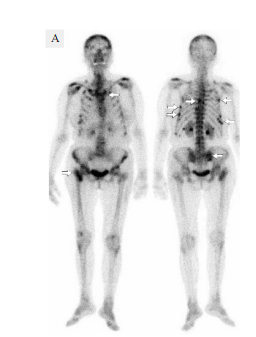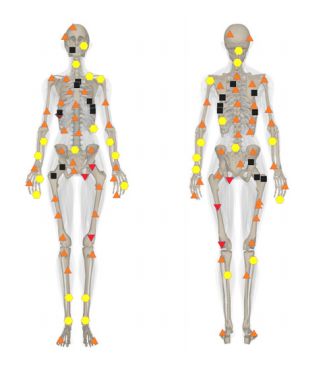

Diagnostics of metastatic skeletal lesions in breast cancer patients with the use of 3D NLS-graphy and bone scanning:
Skeletal system is the most frequent localization area of distant metastases in case of breast cancer (BC). Metastases in bones develop in 30-80% of breast cancer patients in the course of the disease. Bones are affected in the first place in 26-50% of patients who suffer from disseminated form of the disease. According to the information available the mostly affected areas are: vertebral column and pel- vic bones. At the same time the risk of metastatic skeletal affection is high in case of generalized stages of disease; in case of I-II stage of disease the risk does not exceed 2.6%. That is why routine skeletal screening examination aimed at the detec- tion of metastases in early disease patients with no clinical symptoms of bones affection is consid- ered as unreasonable. Bone scan is usually used as a screening method in patients with common form of disease or upon availability of clinical data confirm- ing bones affection. However bone scanning results are frequently uncertain due to low specificity of the method; also such method is not good at detection of lytic metastases. Roentgenologic research methods (including traditional radiography and computer tomography) are used to specify received data. Com- puter tomography is chosen more frequently as long as traditional radiography is under-sensitive and it detects destruction foci only in case of considerable loss of bone substance. Computer tomography allows separate visualizing of cortical and trabecular bones and also surrounding soft tissues, though it also does not provide an early diagnostics of metastatic lesions in bone marrow.
The advantages of new 3D NLS method are: direct display of bone marrow and the visualization possibil- ity of its tumor infiltration before any bone altera- tions appear. Other considerable advantages of 3D NLS-method are: availability, usability and fast rate of examination. The latest technical achievements in this field led to the creation of special modes in 3D visualization (4D Tissue, DeepVision, FastVision) which provide exceptional image quality. Unique ultramicroscanning technique (which ex- ists only in NLS-method) with the use of spectral-en- tropy analysis allow determination of morphological affiliation of the formation according to its spectral similarity to model processes, assess metastatic le- sion of skeletal bones, surrounding soft tissues and lymphatic nodes, determine the presence and type of genetic aberrations in tumoral subclones which even- tually will determine the scope of surgical treatment.

